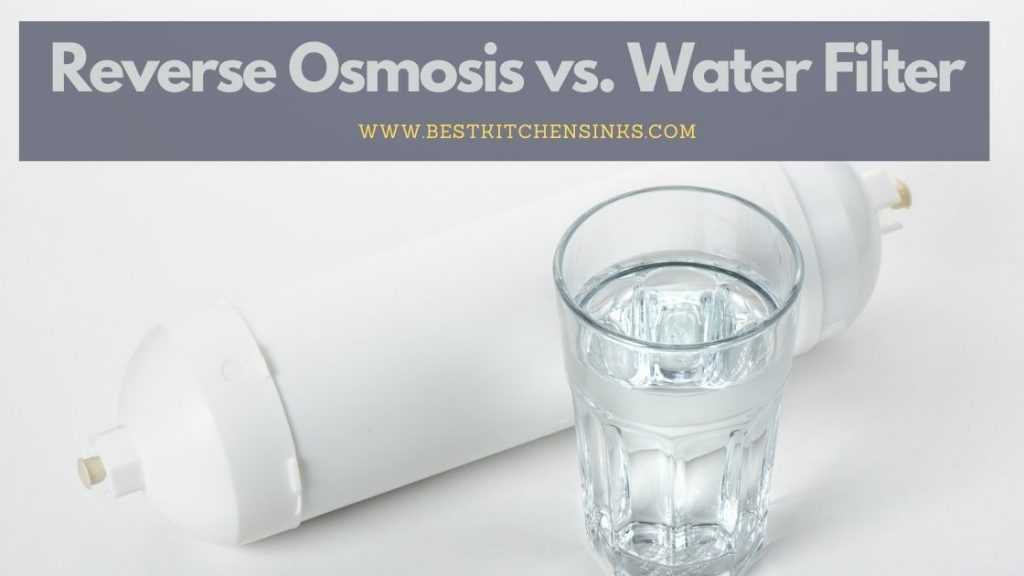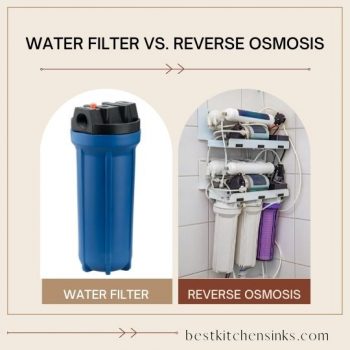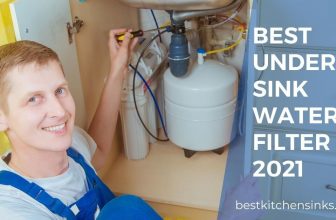Do you know the difference between a water filter and reverse osmosis? We’re here to help! There are many types of filters on the market for homes, from pitcher filters to under-counter filters to whole home filters. Reverse Osmosis systems have become very popular in recent years because they can produce highly purified water. Also, many homeowners opt for under-counter type units or smaller reverse osmosis units for their homes because of space concerns.

A water filter also called a faucet-mounted, or pitcher-style filter, is one of the cheapest ways to provide filtered drinking water. Reverse osmosis, as it sounds, involves running water through a membrane that only allows pure molecules to pass through. For this process to work well enough for your needs, some compromises have been made in taste and flow rate.
Also Read: How to Replace Water Filter Cartridges – Easy Steps to Do it Yourself
What is a Water Filter?
Water filtration is the process of reducing or removing contaminants from your water by using a filter to block them physically. It can remove unwanted chemicals from the tap, like chlorine which has been shown to cause cancer in some cases when consumed over time.
A carbon filter is used in these water filters that use pressure and activated charcoal as its main components, so you’re guaranteed safe drinking without worrying about harmful contaminants!
It is important to know what you should be looking for when buying a water filtration system because they employ the same filtering method to decrease the number of contaminants present in water. They also help reduce various kinds of contaminants more than an RO system in certain situations. The most commonly used filtering media used inside water filters is activated Carbon.
The activated carbon used in these kinds of filters is a specific type of charcoal that is processed with oxygen to expand the charcoal areas. What is the largest surface area? According to estimates, one Gram of activated carbon is an area of more than 32,000 feet. This is crucial since the surface area draws and holds contaminants via a process known as the process of adsorption.
Read: 10 Reasons to Buy a New Kitchen Sink: Simple Points to Remember
Adsorption is the process by which the solid can hold or trap the gas or liquid. In this instance, the porous nature of activated carbon provides it with many tiny areas in which contaminants can be attracted to the carbon and are then remain there.
You might be wondering what makes a good water filter. You’ll want one with high quality to make sure you’re getting the cleanest possible drink, so it’s important that they have complete stages for removing particles or chemicals, thereby ensuring there are no bacteria present in your tap water!
Moreover, a water filter is typically installed at the kitchen tap and provides clean drinking water through your home plumbing system. Some models make your water cold as well.
A water filter is often built into your faucet (like a PUR water filter ), but sometimes you will need to buy an under-counter type. These filters work by using mechanical filtration or adsorption to remove contaminants. Generally, they are not as effective at removing contaminants as compared to reverse osmosis and distillation units.
Benefits of Water Filters
The list of contaminants that carbon water filters remove is impressive. These include:
- Chlorine
- Unpleasant taste and odour
- Dirt
- Sediments
- Rust
- Parasites such as giardia & cryptosporidium
- Heavy metals
- Arsenic
- Volatile organic compounds (VOCs)
The benefits of carbon filters are that it removes harmful impurities from tap water. Not only does this mean you drink better tasting and healthier drinking water, but it also reduces the risk for illness like stomach ulcers or zinc deficiencies by about 80%.
Read: Best Workstation Sink of 2021 – Complete Product’s Reviews & Buying Guide
The benefits of activated carbon water filters are endless. They can remove chemicals, heavy metals, and even radiation! The best thing about these kinds of systems is that they’re not just for people who live in apartments (though we recommend using one as their primary source); anyone with access to hard surfaces could benefit from a filter made out of this material- no matter if your home has pipes or faucets; there’s always room under the sink where you’ll find space enough for an activated carbon water filter.
What is a Reverse Osmosis (RO)?
Reverse osmosis (RO) is a method of purifying water that involves the flow of pressurized water through a biological or synthetic membrane to remove most impurities.
Reverse osmosis has become an increasingly popular form of home filtration because it removes virtually all types of contaminants. However, this system retaining minerals like calcium and magnesium, which are beneficial for human health.
Reverse osmosis is actually pretty simple in concept. It’s basically a method of removing solids from water by pumping them through semi-permeable membranes with high pressure. It’s easy to install, portable, and incredibly effective at removing bacteria and other contaminants.
The Reverse Osmosis Water Purification System filters the water through a carbon cartridge to remove chlorine and sediment. Then it pushes the water through an ultra-fine membrane that removes almost all contaminants, including lead. The final step in this process is polishing our precious water with another set of Carboneum Filters so you can drink without worry! The resulting water is 97% pure.
Benefits of Reverse Osmosis Filters
The reverse osmosis system is a home filtration system. It is a great way to improve the water quality of your home. The Reverse Osmosis System has many uses and applications, such as:
- Removes chlorine from drinking water
- Removes arsenic from well water (non-existent in Des Moines and the surrounding cities)
- Removes fluoride from drinking water
- Removes lead from drinking water. This is most common in older communities. However if you are concerned the reverse osmosis system is easy to put on your home. Please note that reverse osmosis systems do not remove poisons or pathogens from the water.
- Removes nitrates from well water. This is not common in Iowa, but reverse osmosis systems can remove it if you are concerned
- Removes pesticides and herbicides from drinking water. Please note that reverse osmosis systems do not remove poisons or pathogens from the water.
- Removes arsenic from well water (non-existent in Des Moines and the surrounding cities)
- Removes perchlorates from drinking water.
- Removes chromium-6 from drinking water. This is only an issue if you live in the north east United States, such as New Jersey or Pennsylvania.
- Removes mercury from drinking water. This is only an issue if you live near coal fired power plants.
Cost Of Reverse Osmosis Filters
The cost of reverse osmosis systems has come down significantly in the past five years, making them more accessible to most homeowners. Some reverse osmosis units are only $150!
The reverse osmosis water filter is a great way to improve the quality of your drinking water at home. It also saves you money, as reverse osmosis systems pay for themselves after about six months of use.
Also Read: Best Under Sink Water Filter of 2021 – Complete Buying Guide & Reviews
Comparing These Two Systems: What Do They Have in Common?
When it comes to which type of water filter is better, most people will tell you that there’s no real difference between them. But what if I were to warn you: reverse osmosis and filtration systems both remove little bits from your drinking bowl, but they do so by removing slightly different kinds of pollutants?.
In general, Here’s what activated carbon filters can remove from water:
- Volatile organic substances (VOCs) and various other chemicals. These include fuel oil, solvent polychlorinated biphenyls (PCBs), dioxins, and radioactive materials.
- Remove some pesticides, herbicides, and organic contaminants.
- Removes disinfectants that are employed to treat water like chlorine.
- Get rid of the unpleasant flavor and smell of tap water.
Activated carbon filters are great in removing organic compounds. However, they aren’t as effective in eliminating other Contaminants. They include minerals like magnesium and calcium, heavy metals such as lead or fluorine, salts, or microbes.
RO systems can be effective in removing these contaminants from water:
- Salts and Nitrates.
- Metals heavy like lead and copper.
- Reduces the mineral content of hard water.
- Reduces arsenic.
- Some organic chemicals include fluoride, which is added to tap water.
- Protozoa, such as Giardia or Cryptosporidium.
- The viruses include Hepatitis A and Norovirus and Rotavirus.
- Effective in removing bacteria, such as Salmonella, Shigella, and E.coli.
Also Read: Top 11 Best Kitchen Sinks of 2021 – Reviews and Buyer’s Guide
Final Words
The answer can be boiled down to one word: cost. A good quality home system costs around $500 with installation fees and initial set up; this includes the filters for your refrigerator (or other plumbing application) as well! If you want something cheap that will do what it needs without being too complicated, I recommend getting an under sink unit with no pipes sticking out in front of wall space.
However, If you’re looking for a quick way to make water drinkable, the answer is clear. Reverse osmosis systems are more efficient and offer better tasting filtered options than their counterparts.
Additionally, it’s also worth noting that reverse osmosis water filtration systems generate some wastewater as part of the filtration process. Upon passing through the pipeline, wastewater carries away the contaminants that had been removed from the water.





[…] Also Read: Water Filter vs Reverse Osmosis – Which One to Choose? […]
[…] Also Read: Water Filter vs Reverse Osmosis – Which One to Choose? […]